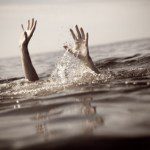 I read a fascinating article on Slate today about how most people can look straight at a drowning person and not realize what is happening because they do not know the signs. The article starts with this story:
I read a fascinating article on Slate today about how most people can look straight at a drowning person and not realize what is happening because they do not know the signs. The article starts with this story:
“The new captain jumped from the deck, fully dressed, and sprinted through the water. A former lifeguard, he kept his eyes on his victim as he headed straight for the couple swimming between their anchored sportfisher and the beach. “I think he thinks you’re drowning,” the husband said to his wife. They had been splashing each other and she had screamed but now they were just standing, neck-deep on the sand bar. “We’re fine; what is he doing?” she asked, a little annoyed. “We’re fine!” the husband yelled, waving him off, but his captain kept swimming hard. ”Move!” he barked as he sprinted between the stunned owners. Directly behind them, not 10 feet away, their 9-year-old daughter was drowning. Safely above the surface in the arms of the captain, she burst into tears, “Daddy!”
Drowning is a pretty good metaphor for mission. How many people around us are drowning in their own lives. A neighbor, co-worker, family member, friend, or church member could be drowning right now and we are not aware of it. We cannot enter in and help because we don’t know the signs. How do we learn to see those who are drowning all around us; drowning in debt, a relational crisis, depression, mental illness, pain, fear, shame, regret, and addiction? I think that very often we direct our energy and focus toward people who are mostly splashing around, and miss the drowning people on the periphery. “Drowning” the article says, “is not the violent, splashing call for help that most people expect.”
To extend the metaphor – a lifeguard has been trained to spot the signs. The father and mother who were ten feet from their drowning daughter didn’t know the signs – they couldn’t see what was happening. Clergy, I think, mistakenly consider themselves to be life guards, but I don’t think that’s quite right. Hauerwas often says that ministry is not a helping profession. We are not psychologists, nurses, and doctors, or life guards. The clergy’s job is teaching other people to swim, and to see the signs that someone around them is drowning so they can take on the mission.
Mission is what we are all involved in clergy and laity alike, and it is like spotting the drowning people, coming around them, keeping their head above water, and helping them learn the movements that will keep them afloat. We learn those movements from Christ and each other. So one of the huge issues facing the church is the ability to spot a drowning victim. The article again:
There is very little splashing, no waving, and no yelling or calls for help of any kind. To get an idea of just how quiet and undramatic from the surface drowning can be, consider this: It is the No. 2 cause of accidental death in children, ages 15 and under (just behind vehicle accidents)—of the approximately 750 children who will drown next year, about 375 of them will do so within 25 yards of a parent or other adult. According to the CDC, in 10 percent of those drownings, the adult will actually watch the child do it, having no idea it is happening. Drowning does not look like drowning—
People are drowning all around us, but we do not know how to spot the signs. The list below is from a Coast Guard training magazine called On the Scene. It details why people can’t cry out for help:
- “Except in rare circumstances, drowning people are physiologically unable to call out for help. The respiratory system was designed for breathing. Speech is the secondary or overlaid function. Breathing must be fulfilled before speech occurs.
- Drowning people’s mouths alternately sink below and reappear above the surface of the water. The mouths of drowning people are not above the surface of the water long enough for them to exhale, inhale, and call out for help. When the drowning people’s mouths are above the surface, they exhale and inhale quickly as their mouths start to sink below the surface of the water.
- Drowning people cannot wave for help. Nature instinctively forces them to extend their arms laterally and press down on the water’s surface. Pressing down on the surface of the water permits drowning people to leverage their bodies so they can lift their mouths out of the water to breathe.
- Throughout the Instinctive Drowning Response, drowning people cannot voluntarily control their arm movements. Physiologically, drowning people who are struggling on the surface of the water cannot stop drowning and perform voluntary movements such as waving for help, moving toward a rescuer, or reaching out for a piece of rescue equipment.
- From beginning to end of the Instinctive Drowning Response people’s bodies remain upright in the water, with no evidence of a supporting kick. Unless rescued by a trained lifeguard, these drowning people can only struggle on the surface of the water from 20 to 60 seconds before submersion occurs.”
Numbers 1 -3 teach me this: most of the time a drowning person – drowning in debt, pain, etc. will not be able to tell you that it is happening. You are going to have to see the signs from other parts of their lives. Part of why they are drowning is that they cannot voice what is happening. Shame, fear, or just ignorance keeps them from being able to cry out for help. Number 4 teaches me to look for people who keep doing things that self-sabotage, acting in ways contrary to their own well being over and over again. These are the folks who are their own worst enemy. Number 5 teaches me that people who are drowning are upright and walking around, but they have no power base. Everything that needs to be happening beneath the surface of their lives isn’t happening. They may not have much time left. Here are the signs of a drowning victim listed in the article. I’m pondering this list today and looking at the ways in which this list might teach me to spot those people who are swimming nearby, barely keeping their heads above the water, in some cases already gasping and struggling to breath:
- Head low in the water, mouth at water level
- Head tilted back with mouth open
- Eyes glassy and empty, unable to focus
- Eyes closed
- Hair over forehead or eyes
- Not using legs—vertical
- Hyperventilating or gasping
- Trying to swim in a particular direction but not making headway
- Trying to roll over on the back
- Appear to be climbing an invisible ladder












